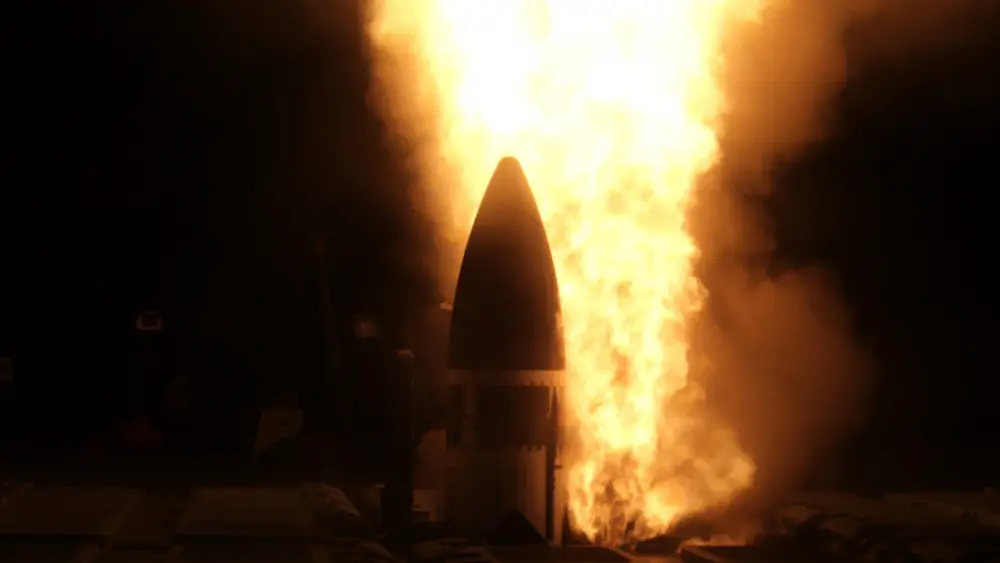U.S. Army Space and Missile Defense Command and U.S. Strategic Command partners support another test of the nation’s missile defense capabilities. Team members of the Joint Functional Component Command for Integrated Missile Defense and USASMDC’s Ronald Reagan Ballistic Missile Defense Test Site, Kwajalein Atoll, Republic of the Marshall Islands, worked alongside U.S. Navy ballistic missile defense forces as they intercepted and destroyed a threat-representative intercontinental ballistic missile target with a Standard Missile-3 Block IIA during a flight test demonstration northeast of Hawaii, Nov. 17.
The ICBM-representative target was launched from RTS, and in this developmental test, a U.S. Navy destroyer used engage-on-remote capabilities through the Command and Control Battle Management Communications network as part of a defense of Hawaii scenario. After receiving tracking data through the C2BMC system the USS John Finn, an Aegis Ballistic Missile Defense System-equipped destroyer, launched an SM-3 Block IIA guided missile, which destroyed the target. During the Flight Test Aegis Weapon System-44, or FTM-44, mission, RTS provided the target launch location; target launch services, such as safety, weather and logistics; and the collection of truth data for determination of system performance.
Based on preliminary data, the test met its primary objective: to demonstrate the ability for the SM-3 Block IIA missile to intercept an ICBM target. Program officials will continue to evaluate system performance based upon telemetry and other data obtained during the test. During these tests, the role of JFCC IMD’s Capability and Resource Integration Directorate, known as the J-8, is to advocate on behalf of the warfighter to ensure ballistic missile defense system capabilities coming from MDA are tested in an operationally realistic manner before being delivered to the warfighter. The J-8 coordinates testing requirements and objectives with the various services, MDA and the developmental and operational test community.
During the test, there are two members of the JFCC IMD Flight Test Team, with additional support from throughout the larger J-8 organization, as needed. After testing is complete and the new or upgraded capability is ready to be added to BMDS operational capacity baseline, JFCC IMD J-87 assesses the testing program and provides a Warfighter Capability Assessment. JFCC IMD is a component of USSTRATCOM, a combatant command with the responsibility for synchronizing global missile defense amongst the other combatant commands. Many tasks associated with this responsibility are delegated to JFCC IMD. It is commanded by Lt. Gen. Daniel Karbler who simultaneously commands both JFCC IMD and USASMDC.
Missile defense operations are conducted by various joint warfighting organizations across the globe using contributing sea, air, land, space and cyber capabilities, said Army Col. Todd Schmidt, Ph.D., director, JFCC IMD Plans, Policy and Allied Integration. JFCC IMD is the recognized subject matter expert across the missile defense enterprise in matters of operational support, policy, strategy, training and education. JFCC IMD operates the Joint Ballistic Training and Education Center in Colorado Springs, Colorado, the Department of Defense’s only certified Joint Center of Excellence. This training facility provides joint missile defense courseware to more than 8,000 students around the world every year.
JFCC IMD also operates a 24-hour, 7-days-a-week operations center at Schriever Air Force Base, Colorado, to provide operational support to the Ground Based Midcourse Defense System, which protects the continental United States, Alaska and Hawaii from missile threats.FTM-44 is a demonstration designed to show the feasibility of establishing a layered homeland defense. “Missile defenses are always more effective if designed with layers that provide multiple intercept opportunities as the threat missile gets closer to the target. The coordination and integration that a layered approach requires is no easy feat but the United States already possesses the individual capabilities and the benefits of linking them would be substantial to deterring potential attacks in a crisis.
















